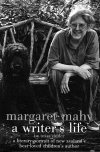
MARGARET MAHY: A WRITER’S LIFE Tessa Duder, HarperCollins, Auckland, New Zealand, 2005, 336 pages paperback, NZ$39.99.
ISBN 1-869540-485-2
Literary Lion Lionised
Forty years ago the New Zealand School Journal published A Lion in the Meadow, by an “impecunious but determined” writer, Margaret Mahy. No story-teller, no matter how brave or fantastical, would have dared make up the tale of how this story got to New York and inspired wealthy publisher Helen Hoke Watts to issue a five book contract and then sweep dramatically into Governors Bay with thirteen suitcases. Like the editor of the School Journal, Mrs Watts had recognised a writer of rare qualities, and was determined to share her shining talent with the world.
Tessa Duder calls her book “a writer’s life” because Mahy preferred her not to go “into a lot of more personal detail”. When I asked Margaret Mahy if, as a busy writer, she had any other life, she responded that, of course she had her family life, and then to my delight added, “And there are all sorts of dramas in a family life.” She told one of her most celebrated family stories, when the family car threatened to erupt into flames, calling out to her fleeing daughters, “Look on this as an adventure.”
Duder tells the smouldering car story twice, to illustrate different points. While Duder has respected Mahy’s privacy, there are nevertheless memorable images of her personal life in this book. There is a moving sketch of her returning home, exhausted from the day’s work, to face the challenge of caring for her children and writing into the early hours. “I’d get off the bus at night and immediately start weeping as I walked towards home.”
In true Mahy fashion, there are lovely anecdotes of how Alzheimer’s Disease affected her Aunt Francie, whose spirit is immortalised in Memory. They capture the humour but do not attempt to hide the strain of the situation.
Everyone has their own favourite Mahy story. I’m sorry we don’t have her tale of how M.K. Joseph, her English lecturer, urged her to try Tolkien, with the result that she purchased the Lord of the Rings rather than a pair of shoes.
Her later fame – a letter from Russell Hoban addressed simply to ‘Margaret Mahy, Christchurch, New Zealand’ was duly delivered – is richly deserved. As well as analysing and assessing Mahy’s work, Duder has created a more complex and fascinating portrait than the stereotype of the literary librarian with the green wig. Of the multifarious Margaret Mahys, Duder has wisely concentrated on introducing only five to her readers: The Young Philosopher, The Apprentice Writer, The Picture Book Writer, The Full-time Novelist and The Doctor of Letters. Duder also presents cameos of Mahy addressing different audiences, from large international reading conventions to a dozen students in a workshop, with wit and eloquence.
While Margaret Mahy may protest at being compared to Janet Frame, it is indisputable that she is a writer of genius, who has indeed raised language to ‘an exciting art-form’. She writes stories that involve and change readers. She is taken seriously in literary circles, and her writings are studied in depth. Critics acknowledge her “interwoven levels of complexity”.
This biography is able to be enjoyed by the general reader but will also serve as a valuable guide to Mahy’s work for readers and a chart for serious students. If this book had an index, it would be perfect
Duder wisely quotes lavishly from Mahy’s superb speeches and essays. Each passage reflects Mahy’s ability to unfold and display what Duder identifies as “the opposing concepts of reality and illusion, truth and imagination, the fabulous in the ordinary, the fantastic in the domestic.”
Duder argues that “as a serious novelist, essayist and thinker, Margaret is much underrated in her own country”, noting she is still being slighted as “only a children’s writer…” There is an additional problem. In her recent elegant and informed Listener essay on the writings of Jack Lasenby (her former School Journal editor), Mahy writes: “Any New Zealand writer for children knows that stories with a strong New Zealand flavour are disadvantaged when it comes to international publishing.” This is a bitter but unavoidable fact, one she has experienced herself; pikelets, scones and steamed puddings were all excised from Jam. Ironically, some nitpicking New Zealanders were complaining that the lion should have been in a paddock, not a meadow.
It is an excellent time to celebrate our national treasure. Margaret Mahy has now entered her 70th year, and her 45th year of writing. This rich biography (which needs two pages just to list her main Awards and Honours, including an amazing two Carnegie Medals and six Esther Glen Medals) and the forthcoming major collection of critical essays, Marvellous Codes: The Fiction of Margaret Mahy, are only two aspects of the celebration. The joint novel and television series of Maddigan’s Fantasia are on the slipways, and another honorary doctorate has been conferred. Even better, A Lion in the Meadow is being reprinted. Mahy has a special affection for this, “the first story of mine that I ever saw turned into a book”.
Best of all Mahy is warning, “I haven’t finished with the lion and some day he may really roar.”
Trevor Agnew
First published in The Press, Christchurch, on May 21st 2005

No comments:
Post a Comment